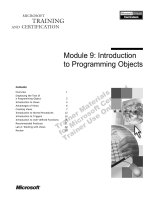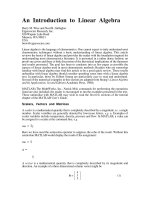9 introduction to linear goal programming quantitative applications in the social sciences james p ignizio
Bạn đang xem bản rút gọn của tài liệu. Xem và tải ngay bản đầy đủ của tài liệu tại đây (1.34 MB, 181 trang )
title:
author:
publisher:
isbn10|asin:
printisbn13:
ebookisbn13:
language:
subject
publicationdate:
lcc:
ddc:
subject:
IntroductiontoLinearGoalProgramming
SageUniversityPapersSeries.Quantitative
ApplicationsintheSocialSciences;No.
07-056
Ignizio,JamesP.
SagePublications,Inc.
0803925646
9780803925649
9780585216928
English
Linearprogramming.
1985
T57.74.I351985eb
519.7/2
Linearprogramming.
IntroductiontoLinearGoalProgramming
SAGEUNIVERSITYPAPERS
Series:QuantitativeApplicationsintheSocialSciences
SeriesEditor:MichaelS.Lewis-Beck,UniversityofIowa
EditorialConsultants
RichardA.Berk,Sociology,UniversityofCalifornia,LosAngeles
WilliamD.Berry,PoliticalScience,FloridaStateUniversity
KennethA.Bollen,Sociology,UniversityofNorthCarolina,Chapel
Hill
LindaB.Bourque,PublicHealth,UniversityofCalifornia,Los
Angeles
JacquesA.Hagenaars,SocialSciences,TilburgUniversity
SallyJackson,Communications,UniversityofArizona
RichardM.Jaeger,Education,UniversityofNorthCarolina,
Greensboro
GaryKing,DepartmentofGovernment,HarvardUniversity
RogerE.Kirk,Psychology,BaylorUniversity
HelenaChmuraKraemer,PsychiatryandBehavioralSciences,
StanfordUniversity
PeterMarsden,Sociology,HarvardUniversity
HelmutNorpoth,PoliticalScience,SUNY,StonyBrook
FrankL.Schmidt,ManagementandOrganization,UniversityofIowa
HerbertWeisberg,PoliticalScience,TheOhioStateUniversity
Publisher
SaraMillerMcCune,SagePublications,Inc.
INSTRUCTIONSTOPOTENTIALCONTRIBUTORS
Forguidelinesonsubmissionofamonographproposaltothisseries,
pleasewrite
MichaelS.Lewis-Beck,Editor
SageQASSSeries
DepartmentofPoliticalScience
UniversityofIowa
IowaCity,IA52242
Page1
Series/Number07-056
IntroductiontoLinearGoalProgramming
JamesP.Ignizio
PennsylvaniaStateUniversity
SAGEPUBLICATIONS
TheInternationalProfessionalPublishers
NewburyParkLondonNewDelhi
Page2
Copyright©1985bySagePublications,Inc.
PrintedintheUnitedStatesofAmerica
Allrightsreserved.Nopartofthisbookmaybereproducedorutilized
inanyformorbyanymeans,electronicormechanical,including
photocopying,recording,orbyanyinformationstorageandretrieval
system,withoutpermissioninwritingfromthepublisher.
Forinformationaddress:
SAGEPublications,Inc.
2455TellerRoad
NewburyPark,California91320
E-mail:
SAGEPublicationsLtd.
6BonhillStreet
LondonEC2A4PU
UnitedKingdom
SAGEPublicationsIndiaPvt.Ltd.
M-32Market
GreaterKailashI
NewDelhi110048India
InternationalStandardBookNumber0-8039-2564-6
LibraryofCongressCatalogCardNo.85-072574
97989900010203111098765
Whencitingaprofessionalpaper,pleaseusetheproperform.
RemembertocitethecorrectSageUniversityPaperseriestitleand
includethepapernumber.Oneofthetwofollowingformatscanbe
adapted(dependingonthestylemanualused):
(1)IVERSEN,GUDMUNDR.andNORPOTH,HELMUT(1976)
"AnalysisofVariance."SageUniversityPaperseriesonQuantitative
ApplicationsintheSocialSciences,07-001.BeverlyHills:Sage
Publications.
OR
(2)Iversen,GudmundR.andNorpoth,Helmut.1976.Analysisof
Variance.SageUniversityPaperseriesonQuantitativeApplications
intheSocialSciences,seriesno.07-001.BeverlyHills:Sage
Publications.
Page3
Contents
SeriesEditor'sIntroduction
5
Acknowledgments
7
1.Introduction
9
Purpose
9
WhatIsGoalProgramming?
10
OntheUseofMatrixNotation
10
2.HistoryandApplications
11
3.DevelopmentoftheLGPModel
15
Notation
16
TheBaselineModel
17
Terminology
18
AdditionalExamples
21
ConversionProcess:LinearProgramming
21
LGPConversionProcedure:PhaseOne
23
LGPConversionProcess:PhaseTwo
25
AnIllustration
26
GoodandPoorModelingPractices
30
4.AnAlgorithmforSolution
32
TheTransformedModel
33
BasicFeasibleSolution
35
AssociatedConditions
36
AlgorithmforSolution:ANarrativeDescription
38
TheRevisedMultiphaseSimplexAlgorithm
39
ThePivotingProcedureinLGP
41
5.AlgorithmIllustration
43
TheTableau
44
StepsofSolutionProcedure
46
ListingtheResults
54
Page4
AdditionalTableauInformation
55
SomeComputationalConsiderations
57
BoundedVariables
59
SolutionofLPandMinsumLGPModels
62
6.DualityandSensitivityAnalysis
63
FormulationoftheMultidimensionalDual
64
ANumericalExample
66
InterpretationoftheDualVariables
68
SolvingtheMultidimensionalDual
69
ASpecialMDDSimplexAlgorithm
72
DiscreteSensitivityAnalysis
75
ParametricLGP
77
7.Extensions
81
IntegerGP
81
NonlinearGP
87
InteractiveGP
89
Notes
91
References
91
AbouttheAuthor
96
Page5
SeriesEditor'sIntroduction
Asthisseriesofvolumesinquantitativeapplicationshasgrown,we
havebeguntoreachouttothoseineconomicsandbusinessinthe
samewaythatsomeoftheearliervolumesappealedmostespecially
tothoseinpoliticalscience,sociology,andpsychology.Ourgoal,
however,continuestobethesame:topublishreadable,up-to-date
introductionstoquantitativemethodologyanditsapplicationto
substantiveproblems.
Oneofthefastest-growingareaswithinthefieldsofoperations
researchandmanagementscience,intermsofbothinterestaswellas
actualimplementation,isthemethodologyknownasgoal
programming.Fromitsinceptionintheearly1950s,thistoolhas
rapidlyevolvedintoonethatnowencompassesnearlyallclassesof
multipleobjectiveprogrammingmodels.Ofcourse,ithasalso
undergoneasignificantevolutionduringthattime.
InAnIntroductiontoLinearGoalProgramming,JamesIgnizio(a
pioneerandmajorcontributortothefield,whosefirstapplicationof
goalprogrammingwasin1962inthedeploymentoftheantenna
systemfortheSaturn/Apollomoonlandingmission)providesa
concise,lucid,andcurrentoverviewof(a)thelineargoal
programmingmodel,(b)acomputationallyefficientalgorithmfor
solution,(c)dualityandsensitivityanalysis,and(d)extensionsofthe
methodologytointegeraswellasnonlinearmodels.Toaccomplish
thisextentofcoverageinashortmonograph,Igniziousesamatrixbasedpresentation,aformatthatnotonlypermitsaconciseoverview
butonethatisalsomostcompatiblewiththemannerinwhichrealworldmathematicalprogrammmingproblemsaresolved.
Thetextisintendedforindividualsinthefieldsofoperations
research,managementscience,industrialandsystemsengineering,
computerscience,andappliedmathematicswhowishtobecome
familiarwithlineargoalprogramminginitsmostrecentform.
Prerequisitesforthe
Page6
textarelimitedtosomebackgroundinlinearalgebraandknowledge
ofthemoreelementaryoperationsinmatricesandvectors.
RICHARDG.NIEMI
SERIESCO-EDITOR
Page7
Acknowledgments
Duringmorethantwodecadesofresearchinandapplicationsofgoal
programming,Ihavebeeninfluenced,motivated,andguidedbythe
worksandwordsofnumerousindividuals.Severalofthese
individuals,inparticular,havehadamajorimpact.Theseinclude
AbrahamCharnesandWilliamCooper,theoriginatorsoftheconcept
ofgoalprogramming;VeikkoJääskeläinen,anindividualwhose
substantialimpactonthepresent-daypopularityofgoalprogramming
hasbeenalmosttotallyoverlooked;andPaulHuss,whointroduced
metogoalprogramming,influencedmydevelopmentofthefirst
nonlineargoalprogrammingalgorithmandapplication(in1962),and
wasmyco-developerofthefirstlarge-scalelineargoalprogramming
code(in1967).Ialsowishtoacknowledgetheinfluenceofthetext,
AdvancedLinearProgramming(McGraw-Hill,1981)byBruce
Murtagh.Murtagh'soutstandingtextanditsconciseyetlucidstyle
havehadparticularinfluenceonthepresentationfoundinChapter4
ofthiswork.Finally,particularthanksaregiventoTomCavalierand
LauraIgnizioforcommentsandcontributionstotheoriginaldraftof
thismanuscript.
Page9
1.
Introduction
Althoughgoalprogramming(GP)isitselfadevelopmentofthe
1950s,ithasonlybeensincethemid-1970sthatGPhasfinally
receivedtrulysubstantialandwidespreadattention.Muchofthe
reasonforsuchinterestisduetoGP'sdemonstratedabilitytoserveas
anefficientandeffectivetoolforthemodeling,solution,andanalysis
ofmathematicalmodelsthatinvolvemultipleandconflictinggoals
andobjectivesthetypeofmodelsthatmostnaturallyrepresentrealworldproblems.YetanotherreasonfortheinterestinGPisaresultof
agrowingrecognitionthatconventional(i.e.,singleobjective)
mathematicalprogrammingmethods(e.g.,linearprogramming)do
notalwaysprovidereasonableanswers,nordotheytypicallyleadtoa
trueunderstandingofandinsightintotheactualproblem.
Purpose
Itisthenthepurposeofthismonographtoprovideforthereadera
briefbutreasonablycomprehensiveintroductiontothemultiobjective
mathematicalprogrammingtechniqueknownasgoalprogramming,
withspecificfocusontheuseofsuchanapproachindealingwith
linearsystems.Further,inprovidingsuchanintroduction,weshall
attempttominimizeboththeamountandlevelofsophisticationofthe
associatedmathematics.Assuch,theonlyprerequisiteforthereader
issomeexposuretolinearalgebraandaknowledgeofthemore
elementaryoperationsonmatricesandvectors.Itshouldbe
emphasizedthatafamiliaritywithlinearprogramminghasnotbeen
assumed,althoughit
Page10
isbelievedlikelythatmostreaderswillhavehadsomepreviouswork
inthatarea.Ithasbeenmyattempttoprovideabriefandconcise,but
reasonablyrigoroustreatmentoflineargoalprogramming.
WhatIsGoalProgramming?
Atthispoint,letuspauseandreflectuponsomeofthenotions
expressedabove,inconjunctionwithafewnewideas.First,letus
notethatgoalprogramminghas,initself,nothingtodowithcomputer
programming(e.g.,FORTRAN,Pascal,LISP,BASIC).Thatis,
althoughanyGPproblemofmeaningfulsizewouldcertainlybe
solvedonthecomputer,thenotionof''programming"inGP(or,for
thatmatter,inthewholeofmathematicalprogramming)isassociated
withthedevelopmentofsolutions,or"programs,"foraspecific
problem.Thus,thename"goalprogramming"isusedtoindicatethat
weseektofindthe(optimal)program(i.e.,setofpoliciesthatareto
beimplemented)foramathematicalmodelthatiscomposedsolelyof
goals.Lineargoalprogramming,orLGP,inturnisusedtodescribe
themethodologyemployedtofindtheprogramforamodelconsisting
solelyoflineargoals.
WeshallwaituntilChapter3torigorouslydefinethenotionofa
"goal."Here,wesimplynotethatanymathematicalprogramming
modelmayfindanalternaterepresentationviaGP.Further,notonly
doesGPprovideanalternativerepresentation,italsooftenprovidesa
representationthatisfarmoreeffectiveincapturingthenatureofrealworldproblemsproblemsthatinvolvemultipleandconflictinggoals
andobjectives.
Finally,wenotethatconventional(i.e.,singleobjective)mathematical
programmingmaybeeasilyandeffectivelytreatedasasubset,or
specialclass,ofGP.Forexample,asweshallsee,linearprogramming
modelsareeasilyandconvenientlytreatedas"GP"models.Infact,
andalthoughtheideaisconsideredradicalbythetraditionalists,itis
notreallynecessarytostudylinearprogramming(LP)ifonehasa
thoroughbackgroundinLGP.
OntheUseofMatrixNotation
Asmentionedearlier,oneoftheprerequisitesofthistextisthatthe
readerhashadsomepreviousexposuretomatricesandvectors,and
theassociatednotation,terminology,andbasicoperationsemployed
insuchareas.Althoughatfirstglancethematrix-basedapproachused
hereinmayappearabitformidabletosomeofthereaders,beassured
Page11
thatitspurposeisnottocomplicatetheissue.Instead,bymeansof
suchanapproachweareableto:
(1)provideapresentationthatistypicallyclearer,moreconcise,and
lessambiguousthanifanonmatrix-basedapproachwereemployed;
and
(2)providealgorithmsinaformfarclosertothatactuallyemployed
indevelopingefficientcomputerizedalgorithms.
Ofparticularimportanceistheconcisenessprovidedviaamatrixbasedapproach.Usingmatricesandmatrixnotationweareable,in
thisslimvolume,tostillcovernearlyalloftheusefulfeaturesof
lineargoalprogramming(e.g.,areasonablycomputationallyefficient
versionofanalgorithmforlineargoalprogramming,acomprehensive
presentationofduality,anintroductiontosensitivityanalysis,and
evendiscussionsofvariousextensionsofthemethodology).Without
theuseofthematrix-basedapproach,therewouldhavebeenno
possibilityofcoveringthisamountofmaterialineventwoorthree
timestheamountofpagesusedherein.
Forthosereaderswhoseexposuretomatricesandvectorshasbeen
limited,orisapartofthenowdistantpast,thereisnoreasonfor
apprehension.Thelevelofthematrix-basedpresentationemployed
hasbeenkeptquiteelementary.
2.
HistoryandApplications
Althoughthereexistnumerousrelatedearlierdevelopments,thefield
ofmathematicalprogrammingtypicallyistracedtothedevelopment
ofthegenerallinearprogrammingmodelanditsmostcommon
methodforsolution,designatedas"simplex."LPandsimplexwere,in
turn,developedin1947byateamofscientists,ledbyGeorge
Dantzig,underthesponsorshipoftheU.S.AirForceprojectSCOOP
(ScientificComputationOfOptimumPrograms).TheLPmodel
addressedasingle,linearobjectivefunctionthatwastobeoptimized
subjecttoasetofrigid,linearconstraints.Oneofthebestdiscussions
ofthisradicalnewconceptisgivenbyDantzighimself(Dantzig,
1982).
Withinbutafewyears,LPhadreceivedsubstantialinternational
exposureandattention,andwashailedasoneofthemajor
developmentsofappliedmathematics.Today,LPisprobablythemost
widely
Page12
knownandcertainlyoneofthemostwidelyemployedofthemethods
usedbythoseinsuchfieldsasoperationsresearchandmanagement
science.However,aswithanyquantitativeapproachtothemodeling
andsolutionofrealproblems,LPhasitsblemishes,drawbacks,and
limitations.Ofthese,ourinterestisfocusedontheinabilityoratleast
limitedabilityofLPtodirectlyandeffectivelyaddressproblems
involvingmultipleobjectivesandgoals,subjecttosoftaswellasrigid
(orhard)constraints.
ThedevelopmentofGPoneapproachforeliminatingoratleast
alleviatingtheabove-mentionedlimitationsofLPoriginatedinthe
early1950s.Atthistime,CharnesandCooperaddressedaproblem
seeminglyunrelatedtoLP(orGP):theproblemof(linear)regression
withsideconditions.Tosolvethisproblem,CharnesandCooper
employedasomewhatmodifiedversionofLPandtermedthe
approach"constrainedregression"(Charnesetal.,1955;Charnesand
Cooper,1975).
Later,intheir1961text,CharnesandCooperdescribedamore
generalversionofconstrainedregression,onethatwasintendedfor
dealingwithlinearmodelsinvolvingmultipleobjectivesorgoals.
Thisrefinedapproachwasdesignatedasgoalprogrammingandisthe
conceptthatunderliesallpresent-dayworkandgeneralizationsofGP.
Inthesame1961text,CharnesandCooperalsoaddressedthenotso
insignificantproblemofattemptingtomeasurethe"goodness"ofa
solutionforamultipleobjectivemodel.Theyproposedthree
approaches,allofwhicharestillwidelyemployedtoday.These
approacheswereeachbasedonthetransformationofallobjectives
intogoalsbymeansoftheestablishmentofan"aspirationlevel,"or
"target.''Forexample,anobjectivesuchas"maximizeprofit"might
berestatedasthegoal:"Obtainxormoreunitsofprofit."Obviously,
anysolutiontotheconvertedmodelwilleitherbeunder,over,or
exactlysatisfytheprofitaspiration.Further,anyprofitunderthe
desiredxunitsrepresentsanundesirableorunwanteddeviationfrom
thegoal.Consequently,CharnesandCooperproposedthatwefocus
onthe"minimizationofunwanteddeviations,"aconceptessentially
identicaltothenotionof"satisficing"asproposedbyMarchand
Simon(Morris,1964).Usingthisconcept,CharnesandCooper
specifiedthefollowingthreeformsofGP:
(1)ArchimedeanGP(alsoknownas"minsum"or"weighted"GP):
Hereweseektominimizethe(weighted)sumofallunwanted,
absolutedeviationsfromthegoals;
Page13
(2)ChebyshevGP(alsoknownas"minimax"GP):Ourpurposeisto
minimizetheworst,ormaximumoftheunwantedgoaldeviations;
and
(3)non-ArchimedeanGP(alsoknownas"preemptivepriority"GPor
"lexicographic"GP):Hereweseektheminimum(moreprecisely,the
lexicographicminimum)ofanorderedvectoroftheunwantedgoal
deviations.
ItisofparticularinterestthatLP(oranysingle-objective
methodology)aswellasArchimedeanandChebyshevGPmayallbe
consideredasspecialcasesofnon-ArchimedeanGPandthustreated
bythesamegeneralmodelandalgorithm(Ignizio,forthcoming).Asa
result,inthisworkwefocusourattentiononnon-ArchimedeanGPor,
morespecifically,onlexicographiclineargoalprogramming.
InadditiontodescribingthelinearGPconceptandproposingthe
abovethreemeasuresforevaluation,CharnesandCooperalso
outlined(again,intheir1961text)algorithmsforsolution.Evidently,
however,actualsoftwarefortheimplementationofsuchalgorithms
wasnotdevelopeduntilthelate1960s.Infact,totheauthor's
knowledge,thefirstcomputercodeforGPwastheonethatI
developedin1962(Ignizio,1963,1976b,1979b,1981b)forthe
solutionofnonlinearGPmodelsmorespecifically,forthedesignof
theantennasystemsfortheSaturn/Apollomoonlandingprogram.
Asaresultofthesuccessofthealgorithmandsoftwarefornonlinear
GP,orNLGP,Igainedaconsiderableappreciationofandinterestin
GP.Asaconsequence,in1967,whenfacedwitharelativelylargescaleLGPmodel(onethatincludedthelexicographicminimum,or
preemptiveprioritynotions),Idevelopedacomputercodefor
lexicographicLGPasbasedonasuggestionbyPaulHuss(personal
communication,1967).Inatelephoneconversationwithme,Huss
proposedthatonesolvethelexicographicLGPmodelasasequenceof
conventionalLPmodels.Thissuggestionwasrefinedandsoftwarefor
theprocedurewasdevelopedbythesummerof1967.Thisspecific
approach,whichIdesignateassequentialgoalprogramming(orSGP;
orSLGPinthelinearcase),althoughunsophisticated,
1resultedinacomputerprogramcapableofsolvinganLGPmodelof
sizesequivalenttothosesolvedviaLP(Ignizio,1967,1982a;Ignizio
andPerlis,1979).Infact,untilquiterecently,SLGP(alsoknownas
iterativeLGPor"decomposed"LGP)evidentlyhasofferedthebest
performanceofanypackageforLGP(havingnowbeensupplantedby
theMULTIPLEXcodesforGP;Ignizio,1983a,1983e,1985a,1985b,
forthcoming).









